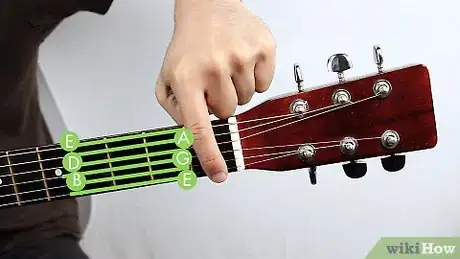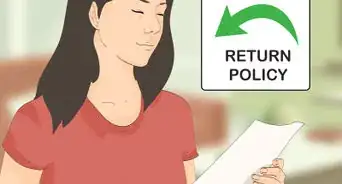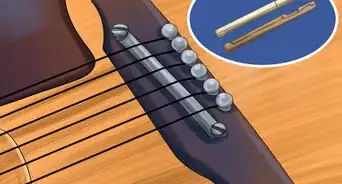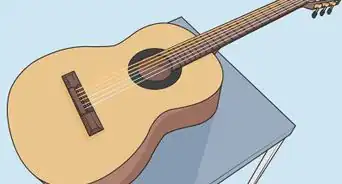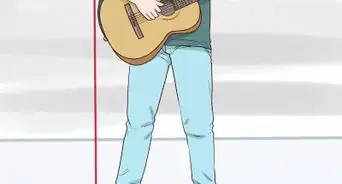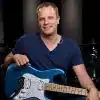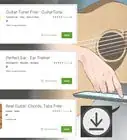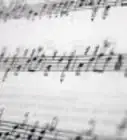This article was co-authored by Nate Savage. Nate Savage is a professional guitarist with over 16 years of experience teaching guitar to students around the world. His YouTube channel, Guitareo, has over 450,000 subscribers.
wikiHow marks an article as reader-approved once it receives enough positive feedback. In this case, 92% of readers who voted found the article helpful, earning it our reader-approved status.
This article has been viewed 437,183 times.
Tablature, or guitar tab, is a simplified system for writing guitar and bass music. Instead of notes or music theory, it simply tells you where to place your fingers, telling you the string and fret of each note you need to play. As such, it is easily learned and, with practice, you can use it to learn almost any song ever recorded.
Steps
Reading Basic Tablature
-
1Review the basics of fret and string numbering. If you're confident finding frets and strings quickly, you can move past this step and onto reading tabs. However, it never hurts to review some guitar basics:
- Fretting: The small metal strips on the guitar neck. If you're right-handed, then the first fret is the one farthest to the left. To play a fret, you push the string down just to the left of fret (right-handed). So, to play the 3rd fret you'd play just to the left of the third metal strip, so your finger is between the second and third frets.
- Strings: The six strings are ordered, starting from the thinnest string on the bottom, as eBGDAE. The thinnest string is the 1st string, the thickest string (on top) is the sixth string.[1]
-
2Consider each of the six lines of a tab as a separate string on the guitar. Tablature uses six lines to tell you which string to play on. The number on the line tells you what fret to play on that string. So recognizing and memorizing these strings is essential to quickly play tabs. The top line is always your 1st string, the higher E-string. The last line is for your sixth string, the thickest string on the guitar. Some tabs label the strings, some do not:
e|-------------------------------------|
B|-------------------------------------|
G|-------------------------------------|
D|-------------------------------------|
A|-------------------------------------|
E|-------------------------------------|[2]Advertisement -
3Play the fret numbered on the tab. When you see a number other than zero, press down in before the fret of that string and play that note. So, if there is a "2" on the second string, you'd play the note on the second fret, second string. If you see "0" you don't hold any frets down. Just play the string openly. In an example:
- e|-----0--2--4--2--0--2--4--2--0------|
- For example, the tab above would simply cycles through three notes, the open E-string, the second fret, the fourth, and then back down.
-
4Recognize chords as multiple notes stacked on top of each other. If there are a few numbers stacked on top of each other then you should play a chord. Play all the notes simultaneously. Fret all of those frets at once and strum the strings that are fretted. Note that any zeros are open strings, and still part of the chord.
- Some tabs also tell you the chord right above the tab, putting a "Gmaj" or "C7" above the tab so that you can read it much more quickly than six simultaneous notes. The chord in the video is a C-major.
-
5Read tabs from left to right, top to bottom. Once you know the basics of tablature, all you have to do to play it is read from left to right. As notes come up, just follow the fretting pattern to play the song. Note, however, that this is just the order of the notes, not the speed and length they're played. This, however, can help you if you're just starting -- you can follow the tab in any tempo you like to get used to the notes, then slowly speed up.
-
6Use a metronome or the original song to help you find the rhythm and feel of the song. Unlike traditionally scored music, tabs may not show how long to play or hold a note. The best way to learn is to play the tab along to the original song, getting used to the timing and feel. Some tabs have a small tempo designation at the top, but since you don't know how long to play each fret for, this may not be very helpful.
- While the distance between notes on the tab is a good guide of pauses and timing, it is just an approximation. Don't expect each space to be perfectly timed out.
- Many tabs have lyrics written near the notes. While not perfect, this is a good way to get used to the timing.
Recognizing Common Special Characters
-
1Palm mute any sections with a P.M.--------------------- over the top. If you see the "P.M." followed by a line over the top of the tab, this tells you to palm mute. Palm muting is when you place the fleshy part of your palm just over the strings, right at the bridge (far-right, for right-handed guitarists), so that your strings sound a little chunky and muted.
- You palm mute all the notes underneath the P.M. line, then stop when it ends.
-
2Play completely muted notes over any "x" symbol. This just means to play a dead string. To do so, use your fretting hand to dampen the string, not fretting a note but not letting it sound out openly either. When you pick it, it should have a percussive, "chick" sound instead of a clear note.
-
3Recognize bends by a "b" or curving upward line. There are two different types of bends in tablature. Professional tabs have a curved line, like the video, telling you to go up. A full-step means you bend the notes enough it sounds two frets higher -- a half-step is one fret higher.
- You might also see a b, such as "A|------2b3------|." This means you bend the second fret up so it sounds like the third fret.
- If you see a downward arrow after the bend or a "2br3," this is a "bend and release." Simply return to the first note, before the bend, after getting up.
-
4Keep track of slides by a backslash between two notes. If you see a slash going from one note to the other, it means you need to slide from one note to the other. So, if you see "D|-----3/5-----|" it means you slide from the third fret to the fifth.
- If there are parenthesis around a number, like "(3)/5," it means the note is a grace note. You want to be sliding off of it right when you pick it, so you never really hear the full 3rd fret.
- There might also be a line above the tab, connecting all of the notes in the slide. This is called a "slur," telling you to play every note smoothly together.
-
5Note hammer-ons and pull-offs by a slur above the tab, or an "h" and "p" between two notes. Hammer-ons and pull-offs are essential for speedy playing and are noted in two ways. First, a slur (or curved line above the numbers), tells you to play the notes smoothly together, hammering and pulling off for every note under the line. The other method is through an h and p for hammers and pull offs, respectively.
- If you were to alternate two notes, it might look like: B|-----2h-4p-2h-------|
-
6Add a little vibrato by shaking the note if there is a curvy line above the tab. Vibrato is simply a rapid, short bend back and forth over a note. Some professional tabs may even have thicker lines telling you how quickly to bend the note -- thicker lines mean more vibrato. It may also be noted by:
- A "v" before or after a note.
- A series of "~" in place of the normal hyphen between notes. Hold the vibrato as long as there are more 20:14, 15 February 2016 (GMT)~ in the tab.
-
7Use any up and down stroke indicators to tell you how to pick or strum. Most tabs don't use stroke indicators, which just tell you how to strum. However, there are some songs where this information is essential to get the right sound, and composers feel like they must add them. They will be above or below the actual tab. All it means is that, when you get to the note lined up with the indicator, you strum that note or chord the proper direction:
- An upside-down "U" means you want to strum downward.
- A "V" shape means you want to strum upwards.[3]
-
8Look up your favorite songs written tablature to practice reading quickly. The best way to learn tab is to use it for songs you already know, helping you get used to the system -- not the song itself. Simply search online for "Song You Want to Play" + "Guitar Tab." Once you know tablature well, you can then use it to learn new songs. Try to practice on a classic -- like this riff from "Sweet Home Alabama.":
E|-------------------------------------------------||
B|-------3---------3----------3--------------------||
G|---------2---------0--------0---------------2p0--||
D|-0-0------------------------0--0----0h2p0--------||
A|------------3-3-------------2---0p2-------0------||
E|-----------------------3-3--3--------------------||
Community Q&A
-
QuestionWhat does "Cadd9 Dsus4" mean?
 George MalenCommunity AnswerCadd9 means you play a C chord only adding the major minor third and the 9th (two fifths higher). These chord types differ from other 9th chords because the seventh is never included. D suspended4 means that the major/minor third is not played and for that reason its place takes a perfect fourth or a major second (most of the time though a perfect fourth).
George MalenCommunity AnswerCadd9 means you play a C chord only adding the major minor third and the 9th (two fifths higher). These chord types differ from other 9th chords because the seventh is never included. D suspended4 means that the major/minor third is not played and for that reason its place takes a perfect fourth or a major second (most of the time though a perfect fourth). -
QuestionWhat size guitar do I need as an 11 year old?
 Community AnswerIt depends on what type of guitar you want. Acoustic and electric guitars usually have smaller necks, so people with smaller fingers would find them easier to play. Classical guitars have a wider neck, so it can be harder for your fingers to reach.
Community AnswerIt depends on what type of guitar you want. Acoustic and electric guitars usually have smaller necks, so people with smaller fingers would find them easier to play. Classical guitars have a wider neck, so it can be harder for your fingers to reach. -
QuestionHow many strings does a guitar need to have in order to play corridos?
 Community AnswerExactly seven strings. Anything else is too much or too little.
Community AnswerExactly seven strings. Anything else is too much or too little.
Warnings
- Guitar tablature may not include time signatures to indicate tempo. It's usually best to start with songs you know well or download a free guitar tablature program so you can hear the music as you play along with it⧼thumbs_response⧽
- You will not be able to play all tabs if this is your first time playing the guitar. Just like with anything else, you have to practice to get better.⧼thumbs_response⧽
